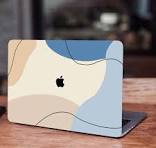The Best Materials for Laptop Skin

Laptop skins are more than just decorative accessories; they serve as a protective layer that can prevent scratches, dust, and minor impacts from damaging the device. Selecting the right material for a laptop skin can be crucial in ensuring durability, aesthetic appeal, and overall satisfaction. This article explores the best materials for laptop skins, examining their benefits and potential drawbacks.
Introduction
Laptop skins have become increasingly popular as users seek ways to personalize their devices while providing an extra layer of protection. The market is flooded with a variety of materials, each offering unique features. Understanding these materials can help in making an informed decision when choosing the best laptop skin.
Vinyl
Characteristics of Vinyl
Vinyl is one of the most common materials used for laptop skins. It is a synthetic plastic polymer that is durable, flexible, and easy to apply.
Advantages of Vinyl
- Durability: Vinyl skins are known for their durability. They can withstand minor scratches and scuffs, making them a practical choice for everyday use.
- Variety: Vinyl skins come in a wide range of colors, patterns, and finishes, allowing users to customize their laptops according to their personal style.
- Ease of Application: Applying a vinyl skin is relatively easy. The adhesive used for vinyl skins is strong enough to stay in place but can also be removed without leaving a residue.
Disadvantages of Vinyl
- Limited Texture Options: While vinyl offers a variety of visual designs, it is limited in terms of texture. Most vinyl skins have a smooth finish, which might not appeal to everyone.
- Heat Resistance: Vinyl can sometimes have issues with heat resistance, potentially leading to warping or peeling in high-temperature environments.
Leather
Characteristics of Leather
Leather laptop skins are premium products that exude sophistication and elegance. They are often made from genuine or synthetic leather and provide a unique tactile experience.
Advantages of Leather
- Aesthetic Appeal: Leather skins offer a luxurious look and feel, making a laptop appear more professional and high-end.
- Durability: Leather is a durable material that can resist scratches and wear over time. It also ages well, developing a patina that adds character.
- Comfort: The soft texture of leather provides a comfortable grip and pleasant tactile sensation.
Disadvantages of Leather
- Cost: Leather skins tend to be more expensive than other materials due to the cost of the raw material and the craftsmanship involved.
- Maintenance: Leather requires regular maintenance to keep it looking its best. It can be susceptible to stains and requires conditioning to prevent drying out.
Carbon Fiber
Characteristics of Carbon Fiber
Carbon fiber is a high-tech material known for its strength and lightweight properties. It is increasingly being used for laptop skins due to its premium look and excellent protective qualities.
Advantages of Carbon Fiber
- Strength: Carbon fiber is incredibly strong and can provide superior protection against impacts and scratches.
- Lightweight: Despite its strength, carbon fiber is very lightweight, which means it won’t add significant weight to the laptop.
- High-Tech Appearance: Carbon fiber skins have a modern, high-tech look that appeals to many users.
Disadvantages of Carbon Fiber
- Cost: Similar to leather, carbon fiber skins are generally more expensive due to the cost of the material and the manufacturing process.
- Limited Design Options: While carbon fiber has a distinct and attractive look, it doesn’t offer the same variety of colors and patterns as vinyl.
Silicone
Characteristics of Silicone
Silicone is a flexible and rubbery material often used in protective cases and skins for electronic devices. It is known for its shock-absorbing properties.
Advantages of Silicone
- Shock Absorption: Silicone can absorb shocks and impacts, providing excellent protection for the laptop.
- Grip: The rubbery texture of silicone offers a non-slip grip, which can help prevent accidental drops.
- Easy to Clean: Silicone skins are easy to clean and maintain, often requiring just a quick wipe down.
Disadvantages of Silicone
- Bulkiness: Silicone skins can be bulkier than other materials, potentially adding to the size of the laptop.
- Aesthetic Limitations: While functional, silicone skins may not offer the same level of aesthetic appeal as other materials like leather or carbon fiber.
Wood Veneer
Characteristics of Wood Veneer
Wood veneer laptop skins are made from thin slices of real wood, providing a natural and unique look. These skins are often handcrafted and offer a premium feel.
Advantages of Wood Veneer
- Unique Appearance: Each wood veneer skin has a unique grain pattern, making each piece one-of-a-kind.
- Natural Feel: Wood veneer offers a warm, natural feel that can be very appealing.
- Eco-Friendly: Wood veneer skins are often considered more environmentally friendly compared to synthetic materials.
Disadvantages of Wood Veneer
- Fragility: Wood veneer can be more fragile than other materials, making it susceptible to cracks and chips.
- Cost: High-quality wood veneer skins can be expensive due to the materials and craftsmanship involved.
Neoprene
Characteristics of Neoprene
Neoprene is a synthetic rubber commonly used in wetsuits and protective gear. It is flexible, durable, and water-resistant.
Advantages of Neoprene
- Water Resistance: Neoprene skins provide excellent protection against spills and moisture.
- Durability: Neoprene is a tough material that can withstand a lot of wear and tear.
- Flexibility: The flexibility of neoprene makes it easy to apply and remove.
Disadvantages of Neoprene
- Thickness: Neoprene skins can be thicker than other materials, potentially adding bulk to the laptop.
- Aesthetic Variety: While functional, neoprene skins may not offer as many design options as vinyl or leather.
Metal
Characteristics of Metal
Metal skins, typically made from thin sheets of aluminum or other metals, provide a sleek and modern look while offering robust protection.
Advantages of Metal
- Durability: Metal skins are extremely durable and can protect the laptop from significant impacts and scratches.
- Sleek Design: Metal skins offer a sleek, industrial look that appeals to many users.
- Heat Dissipation: Metals can help with heat dissipation, potentially aiding in laptop cooling.
Disadvantages of Metal
- Weight: Metal skins can add weight to the laptop, making it less portable.
- Cost: Metal skins are often more expensive due to the cost of materials and manufacturing.
Fabric
Characteristics of Fabric
Fabric laptop skins use a variety of textiles to create a soft and unique covering. These skins can range from cotton to synthetic blends.
Advantages of Fabric
- Customizability: Fabric skins can be easily customized with different prints, patterns, and textures.
- Soft Touch: Fabric skins offer a soft and pleasant tactile experience.
- Breathability: Fabric allows for better airflow, which can help with cooling.
Disadvantages of Fabric
- Durability: Fabric skins can be less durable than other materials and may wear out more quickly.
- Cleaning: Fabric skins can be more challenging to clean and may absorb stains more readily.
Choosing the Best Material
Factors to Consider
When choosing the best material for a laptop skin, several factors should be considered:
- Purpose: Determine if the primary purpose of the skin is protection, aesthetics, or a combination of both.
- Environment: Consider the environment in which the laptop will be used. For example, vinyl or neoprene might be better for outdoor use, while leather or wood veneer might be more suitable for an office setting.
- Budget: Different materials come at varying price points. It’s essential to balance quality and cost.
Personal Preference
Ultimately, personal preference plays a significant role in choosing the best laptop skin. Each material has its own set of advantages and disadvantages, and what works best for one person might not be ideal for another.
Conclusion
Selecting the best material for a laptop skin involves understanding the unique properties and benefits of each option. Vinyl offers durability and variety, leather provides a luxurious feel, carbon fiber combines strength and lightweight properties, and silicone offers excellent shock absorption. Wood veneer adds a natural touch, neoprene provides water resistance, metal ensures robust protection, and fabric allows for customizability and a soft touch.
By considering factors such as purpose, environment, and budget, as well as personal preference, users can find the perfect laptop skin to enhance the look and protect their device. With so many options available, there is undoubtedly a material that will meet the needs and tastes of every laptop owner.











